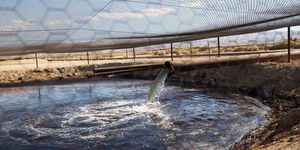NASA Astronaut Nick Hague Describes Experience From Failed Soyuz Launch
Just last week, a Russian rocket tasked with sending NASA astronaut Nick Hague and Roscosmos cosmonaut Alexey Ovchinin to the International Space Station failed to do so. To keep Hague and Ovinchin safe from catastrophe, safety mechanisms built into the crewed MS-10 capsule hoisted it far from the booster rocket to make a safe landing.
Image Credit: Sergei Savostyanov/TASS
Investigations are still underway to discern what caused the rocket failure. But if anything’s sure about the botched launch, it’s that it was almost certainly a one-off instance of bad luck, as the Soyuz platform sports a nearly-spotless track record for reliability and safety.
In the meantime, media sources have turned to the ride’s passengers for exclusive answers about what happened that day and what it felt like. As you might come to expect, being an astronaut helplessly strapped into a malfunctioning rocket system can be a petrifying experience, but the pros are trained to remain calm under all circumstances.
“It went from normal to something was wrong pretty quick,” NASA astronaut Nick Hague explained in an interview. “The first thing I noticed was being shaken fairly violently side to side. Then there was an alarm in the capsule and a light. I knew once I saw the light that we had an emergency with the boosters.”
Related: A Soyuz spacecraft docked successfully with the International Space Station
The light was just one component of an onboard alert system that alerted the crewmembers of a problem. After the light turned on, the capsule’s safety mechanism took over. A few moments later, the capsule was being jettisoned far away from the hazardous booster rocket.
“At that point, I knew we weren’t going to make it to orbit. I looked out the window, and I realized that I got close,” Hague added. “The mission changed to getting back to the ground as safely as we could.”
After the crewed capsule got far enough away from the booster rocket, it deployed emergency landing parachutes that guided it to the ground safely. Just over half-an-hour later, Hague and Ovinchin touched down in Kazakhstan, where recovery crews met with the men to ensure their safety. Fortunately, there were no injuries.
Despite the unpleasant situation, it appears that NASA hasn’t given up on the Soyuz platform just yet. Both space agencies have expressed interest in retrying the launch in the future, perhaps by Spring of 2019. In the meantime, the International Space Station may go without new crew members for a while.
Worthy of note, NASA is working closely with commercial space companies like SpaceX and Boeing to bring future International Space Station launches back to American soil for the first time since the Space Shuttle Program. When things finally move forward, NASA will no longer need to depend on the Russian Soyuz platform for the continuance of space research.
Source: Wired









